“ My corner of paradise is where the fair is”
When we talk about Spain, what image comes to mind?
Let me guess.
A beautiful woman in a long, frilly dress, a fan in her hands and a flower in her hair, right?
Practically a Spanish symbol.

But this feminine image does not originate in big cities like Madrid or Barcelona, despite these and other cities selling souvenirs that refer to Spain, such as fans and roses for hair.
She comes from Sevilla, Andalucia, located in southern Spain.
A place where the Spanish insist on living their traditions.
The main cities in the Andalucia region are:
Seville capital, Córdoba, Málaga, Granada, Ronda and Cadiz, these are the main cities that have history marked on their walls and streets, today with their Christian churches where there were once mosques, they bear the traces of Islamic architecture, rich in details.
In this region, southern Spain, where the beaches where the Moors arrived are located (coming from Africa, from countries such as Morocco, Algeria, Mauritania and the Sahara), the name Andalucia even comes from Al-Andalus, which the Muslims gave to the Iberian Peninsula in the 8th century. 
Don't miss the opportunity to get to know the culture and traditions of these women who are the hallmark of Spain.
In the month of April, when the Feria takes place.
In Seville, as it is the capital of the region, the festival is bigger and much better known.

But what is the Feria?
It is an idea of two Sevillians José María Ibarra and Narciso Bonaplata who in 1846 decided to create an annual livestock fair in the month of April lasting three days, yes the objective of the fair was the purchase and sale of cattle, over time the festive part became more important than the commercial part, today it is a 6-day meeting where locals and visitors have fun with music, dance, gastronomy and decoration and without the cattle.
Knights and Amazons parade through the city, with their decorated carriages and horses.

It is worth getting to know the culture of this symbol that is a trademark of Spain.
It's literally an open-air parade.
Men wear their suits and women wear their famous dresses.
Hair and makeup worthy of a big party.
And it's an open-air parade, because this week people walk the streets in costume, go to restaurants and bars, and to get to the party venue, they go by car, scooters and most of them use public transport, all the buses are full, and all the people are dressed up for the party.
It seems like we've entered a film from another time.
Dresses: Dresses are not simple dresses. They are costumes that carry history. They are passed down from mother to daughter, there is something for everyone, for all tastes and values.
In a department store we found these dresses starting at €$700.00 euros, so prepare your wallet if you want to buy one.
Of course, in the city center, some stores sell accessories at very affordable prices.
Flamenco: Women dance, and they dance a lot.
In fact, traditionally, they learn flamenco from a young age. It is common to walk down the sidewalk and see a 4-year-old girl wearing high heels going to dance school.
At the fair, women dance with great joy, it is contagious to see.
And when they dance with their partners then!!!
It is worth remenbering thatbfamenco dance is an expression where feelings of love, passion and sadness are demosntrated trhrough facial expressions, steps and striking movements, some of which are sung wirh a voice choked with sadness.






Another insteresting fact is that women use a small purse as if it were a bag made of the same fabric to put their personal belongings, or under the skirt of the dress there is a pocket alteady sewn in, or even a garter belt with a pocket.
This way, they have their hands free to dance.




Last year we were there.
It seems like yesterday.

